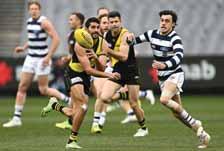
8 minute read
Football’s Survivors and Thrivers
Optus Stadium during the 2021 AFL Grand Final. Football’s survivors and thrivers
Dr Hunter Fujak explains the state of Australia’s Code Wars
Advertisement
If we take a broad view of the global sport marketplace, it is uncontroversial to state that football (soccer) is the most culturally dominant sport in most domestic settings. It is rather uncommon for soccer not to be a nation’s favourite sport, and even less common for a nation to prefer another form of football over soccer. However, Australia sits alone as a sole outlier, as the only nation where four football codes operate at a commercial level, and soccer is not a clear favourite.
When one further considers that Australia hosts a tennis grand slam tournament, Formula 1 and MotoGP series tour events, and will host its third Olympics in 2032, the nation certainly achieves a sporting pedigree that belies its population.
For comparison, Australia is similar in population size to Taiwan or Romania, yet with a far more advanced sport market. Whereas Taiwan’s professional sport market featured 21 teams in 2019, Australia featured 120 teams across its seven largest commercial sport leagues. It is this breadth of passion across sports that, I argue, positions Australia as the most distinctive sport marketplace in the world.
While an abundance of sport content has been a boon for the purchasing power of sport fans, it has contributed to a cut-throat competitive intensity within the Australian sport sector for the hearts and wallets of consumers. This intensity, particularly in the context of the hyper-competitive football landscape, is


The Wallabies line up. the core focus of my recently published book: Code War$: The Battle for Fans, Dollars and Survival. Although our football codes have been entrenched in competition for over a century, the onset of COVID-19 has coincided with broader industry challenges and transformation. Accordingly, the 2020’s may represent the most profound period of industry development since the onset of sport sector’s hyper-commercialisation during the 1970s. Our modern football landscape: chance or fate? What differentiates Australia from more typical sport settings is not only that we have multiple football codes, but that their respective popularity remains so heavily geographic-centric. The Australian Football League (AFL) retains an average 89% share of Google search volume across the four football leagues across southern states, while the National Rugby League (NRL) achieves an equivalent 63% search volume share in northern states. By contrast, North America’s National Football League (NFL) is the most searched league among the National Basketball Association, Major League Baseball and National Hockey League in every state of the USA, including regions without a local NFL team. Such Google search data also reveals the AFL’s generational success in northern expansion, as compared to the NRL’s laissez faire approach to expansion. Whereas the AFL achieves a 31% share of search in northern markets, the NRL achieves just 7% in southern states.
Despite the ingrained dominance of particular codes within particular regions, history reveals that many tantalising ‘what if’ scenarios have shaped our modern football landscape. For instance, West Australia’s inaugural football code from 1881 was in fact rugby union. Rugby held ground for three seasons, until overthrown by Australian rules advocates. The now all-powerful West Australian Football Association (WAFA) was the last Australian rules state association to form, doing so on the 8th May 1885. So too in Brisbane does the current day passion for rugby, in particular the league variety, conceal that the state’s first football club was aligned to Melbourne rules. Melbourne

AFL action between Richmond and Geelong.





Australia’s national football teams are well positioned for fan engagement following Tokyo 2020.
rules were in fact dominant for much of the period from Queensland football’s commencement in 1866 until 1886. Queensland only became a rugby state after the NSWRU (rugby union) successfully undermined the NSWFA (Australian rules) to secure exclusive interstate tour matches in 1882, which proved to be rugby’s catalyst in Queensland.
Perhaps the most interesting football history resides in Tasmania, the ramifications of which persist today by virtue of the state’s exclusion from the AFL competition. Tasmania did not settle on a particular football code until 1879, prior to which it was rugby and soccer that were played. It was agreed that during the 1879 season each of the three codes would be played in rotation, to give participants an adequate chance to compare them. Following this, a vote was to be held to determine which code to adopt. Victorian rules won the ballot by just a single vote, allowing the code to become the ingrained preference of Tasmania thereafter. Organised rugby would only re-emerge 50 years later in 1933 with the formation of the Launceston Rugby Club. Given the current tensions that surround the pathway to a local AFL team, many locals may no doubt wonder whether the state’s loyalty to Australian rules has been adequately rewarded since this fateful vote. Australia’s crowded sport marketplace Australia’s moniker as a ‘sport mad’ nation is indeed validated by empirical research, with approximately 80% of Australians self-identifying as sport fans, and 65% of Australians as supporters of at least one football code. Among football fans, approximately half solely support one code and the other half support multiple codes. Perhaps of greatest insight, however, is how divergent Australia’s northern and southern states are in terms of the structure of football fandom within their populations. Whereas approximately a third of the population in Melbourne, Adelaide or Perth are exclusively interested in Australian rules, only 14% of Sydney and Brisbane residents are exclusively interested in rugby league. Correspondingly, Sydney has the highest proportion of football fans who support two (18%), three (8%), or all four codes (5%). Therefore, while Melbourne has long been positioned as Australia’s ‘sports capital’, Sydney may well be Australia’s sport-diverse capital.
Fandom data confirms that AFL’s success in the code war has largely stemmed from its ability to maintain a cultural iron grip in southern markets, not matched by the rugby codes in northern markets nor soccer’s diminished but evenly distributed national popularity. If one were to walk into a sports bar in Melbourne, Adelaide or Tasmania, approximately 80% of attendees would be interested in AFL and more than half the pub solely interested in AFL to the exclusion of all other football codes. This cultural dominance has translated into a financial dominance. When the AFL’s independent commission was established in the mid-1980s, the AFL had total net assets of only $3 million and many of its clubs were teetering upon financial collapse. Approaching 40 years later, the AFL derived as much central revenue as the combined total of the NRL, Football Australia and Rugby Australia for period 2012 to 2019. Can Australia continue to sustain so much football? While Australia has long been understood to be a competitive sport market, the football codes have largely operated in equilibrium over the long span of history. Key to their co-existence has been the steady escalation in the overall value of media rights, which has benefited all four codes, albeit asymmetrically. Alarmingly however, the financial gap between our codes appears to be growing in not just absolute but also relative terms. In rugby union’s second year of professionalism, their revenue ($21 million) was a quarter to that of the AFL’s ($85 million). By 2019, Rugby Australia’s revenue ($112 million) was only 14% that of the AFL’s



Fremantle Dockers fans (above) and NRL action between Cronulla and the Cowboys (below left).
($794 million). In 2020, the Richmond Tigers generated more revenue as a single AFL club than Rugby Australia did as a national sporting association, for the first time in the professional era.
Despite the onset of COVID-19 ravaging the ability of sport clubs and leagues to generate revenue, our football landscape appears intent on growing rather than shrinking. The confirmation of an imminent 18 team AFLW will see the Australian rules season start deeper in summer, resulting in an Australian rules calendar that is eleven months long. The NRLW too has been expanded, allowing rugby league to continue into November for 2021 at least. Where previously the Australian sport calendar divided neatly between discrete summer and winter seasons, the modern sport calendar is hence undoubtedly cluttered. In the process, sport consumer attention is increasingly fragmenting across a growing abundance of viewing alternatives, further facilitated by falling production costs that has seen more semi and nonprofessional sport content broadcast on a growing number of platforms. Although the competitive tension created from new digital media platforms may continue to fund our football codes, when it comes to the pursuit of the hearts and minds of Australian sport fans, the code wars have perhaps never been as intense as is the case today. Dr Hunter Fujak is a Lecturer in Sports Management at Deakin University. His research focus includes sport consumer behaviour and broadcasting, and has previously consulted across audience and sponsorship for Australasia’s largest sporting leagues, events and brands. His recently published book, Code Wars - The Battle for Fans, Dollars and Survival, provides a cutting-edge analysis of the past, present and future of the Australian commercial sport landscape.
Code Wars is published by Fair Play Publishing, and is available from bookstores and direct from the publisher. For details contact 02 7229 4889, E: sales@fairplaypublishing.com.au


















